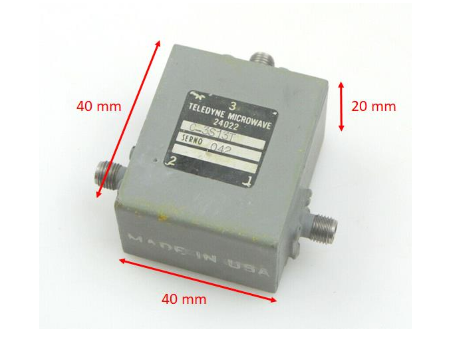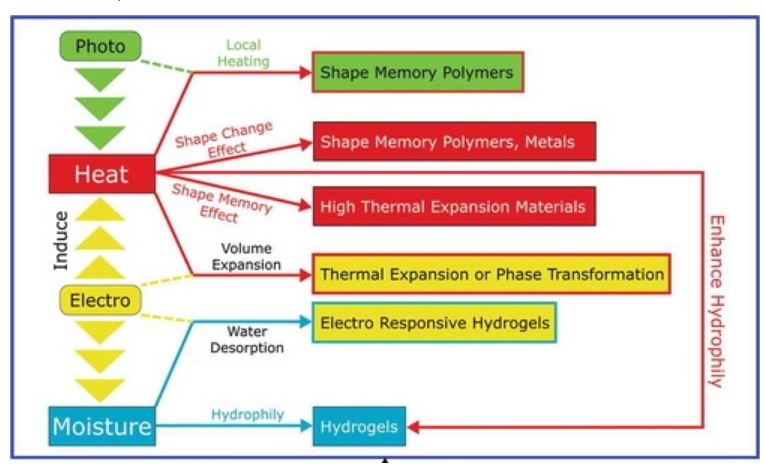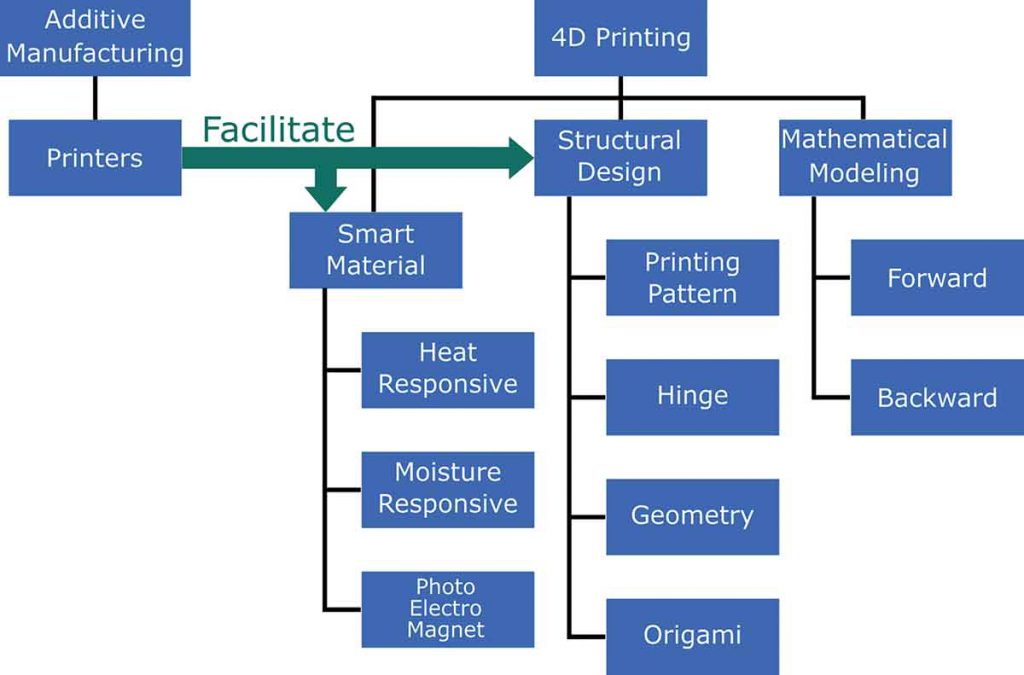PLA: The Effects of Annealing & Autoclaving on Mechanical Behavior of Desktop FDM Parts
Researchers from the University of California delve into a very important area of 3D printing for the medical field, experimenting with how sterilization processes affect materials. They released their findings in the recently published ‘Identifying a commercially-available 3D printing process that minimizes model distortion after annealing and autoclaving and the effect of steam sterilization on mechanical strength.’
3D printed models are currently changing the face of medicine in terms of patient-specific treatment, allowing for better diagnosis, education for patients and their families (and medical students), along with acting as pre-planning tools and surgical guides.
In relation to FDM 3D printing in medicine, the authors refer back to previous studies concluding that PLA was weakened by sterilization yet strengthened in annealing, explaining that the next viable step would be to find a 3D printing material that can withstand heat treatment and steam sterilization.
The team fabricated four 30 mm cubes as samples for the study, each featuring different infill—designed in Tinkercad and then 3D printed on a LulzBot Mini 3D printer.
Samples were printed all at once, using 0.38 mm layer height and a 0.5 mm printhead nozzle. Materials tested included:
- ColorFabb Woodfill
- Dragons Metallic PLA in All That Glitters Gold
- Essentium PLA in Gray
- Maker Series PLA in Food Safe FDA OK Clear
- Maker Series PLA in White HOT White
- Proto-Pasta HTPLA in White
- Raptor Series PLA in HD Vivid Blue

a) Infill geometries clockwise beginning from top-left: tetrahedral, triangles, grid, zig-zag and b) 3D printed cubes
Each sample was bathed in hot water, with the annealing treatment performed via an 800 W Strata Home sous vide circulating precision cooker.
“The cubes were removed from the hot water-bath and allowed to cool to room temperature without interference. The X, Y, and Z dimensions of the cubes were measured again to quantify deformation and calculate percent changes, a positive percent change indicating expansion and a negative percent change indicating shrinkage,” explained the researchers.
“In order to quantify distortion in either direction, we took the absolute value of these percentages. Subjective observations were noted such as spherical ‘balloon-like’ expansion. We also analyzed whether certain materials consistently expanded or contracted in every axes.”
Samples were then placed in autoclave sterilization pouches and deposited into a Tuttnauer 2540 M autoclave for 45 minutes at 134 °C and a pressure of 375 PSI. Afterward, the samples were cooled to room temperature and then examined for any signs of deformation.

a) Standard Army-Navy retractor and b) strength-optimized Army-Navy retractor designs in inches created in AutoDesk Fusion 360 obtained from Chen et al. c Retractor orientation on the build plate to eliminate need for support material
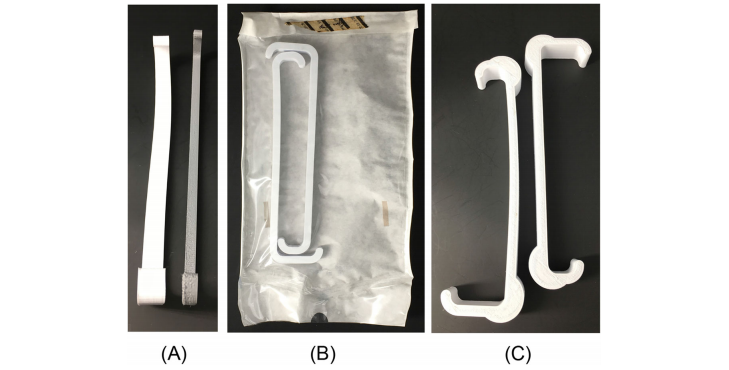
a) Standard retractors warping after hot water-bath annealing and b) after autoclaving. c) Strength-optimized retractor without intervention (right) and warping after hot water-bath annealing (left)
The material exhibiting the least amount of deformation was Essentium PLA Gray. The highest deformation was noted in Maker Series PLA White HOT White.
“After hot water-bath annealing for 30 mm cubes, the infill that deformed the least was ‘grid,’ and the infill pattern that deformed the most was ‘zig-zag.’ After both annealing then autoclaving for 30 mm cubes, the material that deformed the least was Essentium PLA Gray. The material that deformed the most was Maker Series PLA White HOT White. After both annealing then autoclaving for 30 mm cubes, the infill pattern that deformed the least was ‘grid,’ and the infill pattern that deformed the most was ‘tetrahedral.’”

Quantifying absolute deformation in 30 mm cubes across 3D printing materials after annealing then autoclaving

Quantifying absolute deformation in 30 mm cubes across infill geometries after annealing then autoclaving
Maker Series PLA White HOT White was the only material noted to expand in every axis—despite the infill geometry or intervention. Every other material showed variances due to infill. Expansion after annealing usually seemed to suggest ‘direction of distortion’ after autoclaving.
“We acknowledge that dimensional changes and strength limitations may not be a challenge at a lower autoclave cycle, which would require further testing. We have also yet to understand the mechanical behavior of the 3D printed models in this study when they are subjected to multiple cycles of autoclaving and whether they will continue to undergo dimensional change. However, regardless of whether 3D printed PLA surgical instruments are determined to be single or multi-use, these instruments may still be valuable in fields such as aerospace medicine where space limitations exist, or in resource-limited situations where additional instruments are needed,” stated the researchers.
“This study is intended as a pre-clinical evaluation of the mechanical behavior of FDM 3D printing materials following hot water-bath annealing treatment and autoclave sterilization. For FDM 3D printed Army-Navy retractors, further sterilization and biocompatibility validation will be necessary for it to be applied clinically.”
What do you think of this news? Let us know your thoughts! Join the discussion of this and other 3D printing topics at 3DPrintBoard.com.
[Source / Images: ‘Identifying a commercially-available 3D printing process that minimizes model distortion after annealing and autoclaving and the effect of steam sterilization on mechanical strength’]
The post PLA: The Effects of Annealing & Autoclaving on Mechanical Behavior of Desktop FDM Parts appeared first on 3DPrint.com | The Voice of 3D Printing / Additive Manufacturing.
RCAM Technologies and Accucode target 3D printing for offshore wind turbines
University of California: 3D Printing with Magnetics & Hexaferrite Materials
Max Ho of the University of California recently published his dissertation, ‘Magnetic 3D Printing of Hexaferrite Material,’ exploring the use of progressive technology and materials, and the potential in possible applications like miniaturization and circulator integration. Ho chose 3D printing as the technology of choice because of the ability to fabricate complex technologies with the addition of magnetic material.
For this study, Ho chose hexaferrite particles due to ‘strong magnetocrystalline anisotropy and low conductance,’ able to rotate to the field direction rather than changing direction. The research team created hexaferrite particles and a liquid polymer, SU8.
“3D printing of this composite with poling will make direct printing of magnetic components that require out-of-plane and in-plane anisotropic magnetization possible,” explains Ho.
Millimeter wave, an electromagnetic spectrum, corresponds from 30 to 300 GHz—a regime that is ‘ideal’ for both satellite and covert radar communications.
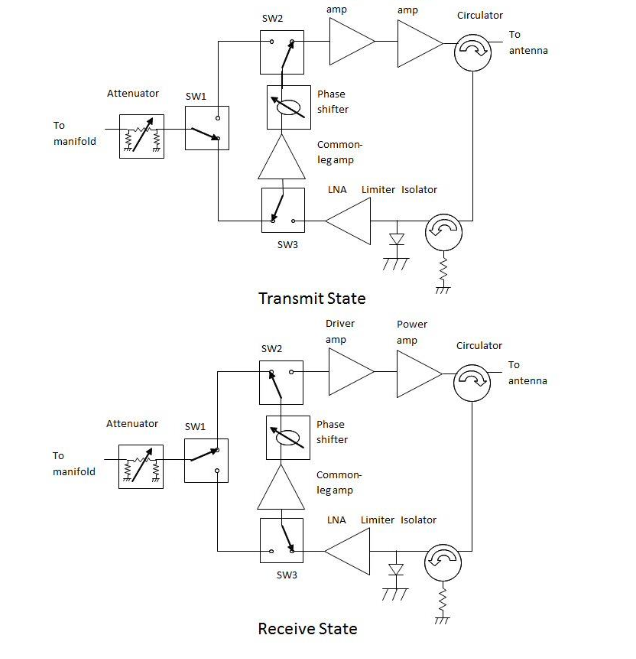
The circulator allows the single antenna to be shared between the transmit and receive states. The isolator (circulator with a grounded port in the block diagram) protects the antenna from the reflected signal. The limiter prevents damage to the low noise amplifier during transmit or whenever stray radiation is present, and the low-noise amplifier (LNA)sets the noise figure of the system, but all losses between the antenna and the LNA add to the overall noise figure and must be minimized. The phase shifter and often the attenuator is used in both transmit and receive paths. In this block diagram, an amplifier and the phase shifter are configured in the common-leg circuit(CLC). The attenuator is used to add an amplitude taper across the array, to reduce sidelobes. This is typically only done in receive state.
The communication systems would use radio frequency (RF) transmit and receive (T/R) modules to boost output power, establish system noise figure for receiving, along with offering beam steering control. The use of a single antenna would be best in this scenario, with a circulator controlling signal flow.

Schematics illustrate the functions of a circulator (duplexer) and an isolator[5]. A circulator in a T/R module controls the flow of signals among the transmitter, antenna, and receiver. An isolator is a circulator with a grounded 3rdport and blocks reflected signal back to signal source.
Magnetic components are required for millimeter wave systems, and the modules are created with:
- Monolithic microwave integrated circuits (MMICs)
- Circulators
- Isolators
- Inductors

This is areal T/R module used in a Euro Typhoon Fighter’s active phased array radar. On the left, this is just one component, a circulator, and on the right, you have quite a few Monolithic Microwave Integrated Circuits, or MMIC, such as low-noise amplifiers, high power amplifiers, and complementary metal oxide semiconductor devices. The circulator, which is a magneticcomponent, is built separated from the MMICs. This type of components uses magnetic materials that exploit unique physics and functionality not available in semiconductor materials[4]
3D printing has proven itself useful and versatile in terms of magnetic composites, along with other materials:
“A class of smart materials known as magnetorheological elastomer, composites of polymer and magnetic materials, has been fabricated via traditional techniques and only recently by 3D printing. Prior research has demonstrated printing magnetic composite and poling it in the plane of printing [16], [17], where poling is the act of setting the magnetization of the composite in a desired direction. The same concept and technique can be applied to different magnetic materials, such as hexaferrite.”
The team used FDM/FFF 3D printing, selecting a Hyrel M30 printer. Thermoplastic filaments can be used, along with liquid or gel composites. While there are many obstacles in using hexaferrite, a blend of particles and photoresist has been found to work in prior studies—but the research team here thought the use of 3D printing would make the process even more versatile than with the use of traditional methods. And while they were able to meet their goals, Ho states that ‘there is always room for improvement.’
Ho suggests the use of single domain hexaferrite particles, or the possibility of replacing the polymer matrix with less solvent, along with in situ poling.
“This technique of 3D printing with a composite of magnetic material in a polymer matrix has a broader range of application beyond just millimeter-wave magnetic devices. Either the magnetic material or the polymer matrix can be changed to different varieties, depending on the application,” says Ho. “For example, the magnetic particles can be made of NdFeB, which would have very high magnetization and suitable for low-frequency applications.”
“The polymer matrix can also be changed from SU8 to silicone-based polymer or PDMS, which is not photosensitive. If the composite meets the requirements outlined in Chapter 2, it can used in a 3D printer of FDM/FFF-type.”
Composites and other materials with the use of magnetics are growing in popularity within 3D printing, for everything from use in microgravity to sensors, functional assemblies for medical devices, and more.
What do you think of this news? Let us know your thoughts! Join the discussion of this and other 3D printing topics at 3DPrintBoard.com.
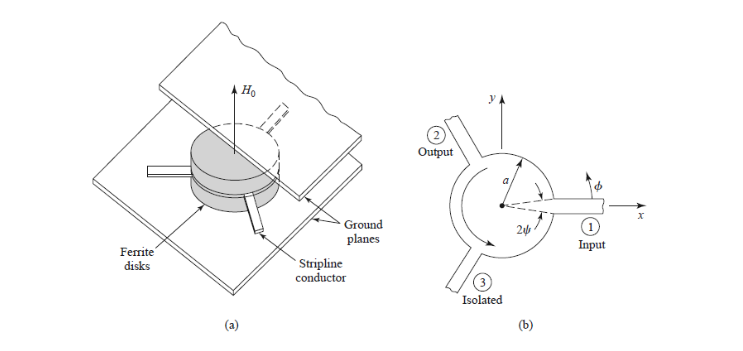
Both types also rely on the presence of an asymmetrical magnetic field provided by the magnetized ferrite. From the perspective of an electromagnetic wave traveling toward the junction, the geometry would be identical from every port. However, the field distribution of the wave inside the waveguide is not symmetrical. The H fields are polarized elliptically in planes either along or normal to the traveling direction and is of opposite orientation in either side of the waveguide. Since permeability is a tensor and thus depends on the orientation, the wave will experience asymmetry as it passes through the external magnetic field from the magnetic ferrite. A mathematical analysis of the structure that explains how a circulator works is iterated below.
[Source / Image: ‘Magnetic 3D Printing of Hexaferrite Material’]
The post University of California: 3D Printing with Magnetics & Hexaferrite Materials appeared first on 3DPrint.com | The Voice of 3D Printing / Additive Manufacturing.
Liquid magnets made possible by Berkley lab 3D printing
Berkeley researchers 3D print all-liquid device for batteries and drug formulations
Berkeley Researchers Studying Progress & Challenges in 4D Printing
 While 3D printing allows for many users to create complex geometries not before possible, 4D printing does that and more with materials and textures that respond to their environment and then revert to their original shape when exposed to other features like temperature. Zhizhou Zhang, Kahramen G. Demir, and Grace X. Gu (all from University of California, Berkeley) explore 4D printing and all its surrounding details in ‘Developments in 4D-printing: a review on current smart materials, technologies, and applications.’
While 3D printing allows for many users to create complex geometries not before possible, 4D printing does that and more with materials and textures that respond to their environment and then revert to their original shape when exposed to other features like temperature. Zhizhou Zhang, Kahramen G. Demir, and Grace X. Gu (all from University of California, Berkeley) explore 4D printing and all its surrounding details in ‘Developments in 4D-printing: a review on current smart materials, technologies, and applications.’
As the authors point out, 4D printing has continued to progress with further inventions in technique and materials. This gives it even more potential in applications like self-constructing structures, medical devices, and soft robotics, although there are still obstacles. FDM and SLA 3D printing are most commonly used for creating 4D objects made of metamaterials that can be flexible or cushioning as needed, good for products like lifters, microtubes, robotics, and toys too.
“To achieve directional shape change (contrary to trivial uniform swelling), the 4D-printed structure will consist of material anisotropy,” state the researchers. “This requires congruently printing a combination of multiple materials.”
Currently, the classes of materials being used in 4D printing are:
- Thermo-responsive
- Moisture-responsive
- Photo-responsive
- Electro-responsive
- Magneto-responsive
Self-construction structures are one of the most promising areas of 4D printing, with items such as self-folding cubes offering the potential for changing the world of packaging forever due to shape memory effect. Other important devices include self-rolled cylindrical tubes constructed with even distributed smart polymer grids.

4D-printed self-construction structures. (a) A self-folding cubic container printed from SMPs (b) A self-rolling tube container printed from smart polymers and actuated by acetone (c) A complex curved surface deformed from a flat state that was printed using moisture-responsive polymers (hydrogels) with a gradient distribution (d) A sequentially folded stipe that can lock itself. The joints are printed with different combinations of SMPs (e) Self-nested boxes whose joints are printed with SMPs in different colors (f) Cross-folding test specimens with and without a stress release hole (g) Conceptual design of a material with tunable lattice structure that permits bandgap control (h) Multifunctional material with tunable Poisson’s ratio.
“Smart materials can also be printed in a gradient distribution to allow researchers to control the surface curvature of a print,” state the authors in their paper. “This technology can greatly save space by fabricating structures as flat shapes. It is also capable of realizing complicated surface curvatures that are difficult to manufacture through traditional methods.”
One of the main benefits of 4D printing is in how it can control materials, with researchers continuing to make progress in this area. 4D printed materials are already being used in the medical field for devices such as prosthetics, implants, splints, stents, and even pharmaceuticals and targeted drug delivery. As 3D continues to be paired with robots—whether in making parts for them or in creating robots that can operate 3D printers—taking it to the next level in soft robotics with 4D printing is logical:
“Traditional robotics, primarily due to being made of rigid materials, have limitations in performing organic and compliant operations such as the grip of a human hand or the intricate motion of an octopus tentacle. Consequently, the field of soft robotics emerged in which certain soft materials, mainly special types of elastomers, are utilized as the interaction interface between robots and their environment,” state the researchers. “These soft materials allow for a gentle interaction with fragile objects and, when compared to traditional robotics, allow for a better tolerance towards damaging forces.”
Objects printed with complex geometries and no need for support structures or excessive post-processing procedures are made possible with some inkjet printing techniques also—allowing for the creation of durable actuators.
Current challenges in 4D printing are substantial though, including most hardware and materials, restrictions in mechanical properties, ‘slow and inaccurate actuation,’ along with insufficient control of varying phases of deformation.
“Advancements in printable smart materials, mathematical models, and printing technologies will allow for 4D-printing to further enhance surgical treatments, targeted drug delivery, soft robotics, and other unthought-of fields in engineering,” conclude the researchers.
The 4D realm continues to expand—and fascinate users everywhere—with innovations that not only form to their environments, but provide users and industry with exactly what they need in a wide range of applications whether for artistic endeavors, microfluidic structures, or seating for luxury vehicles. What do you think of this news? Let us know your thoughts! Join the discussion of this and other 3D printing topics at 3DPrintBoard.com.
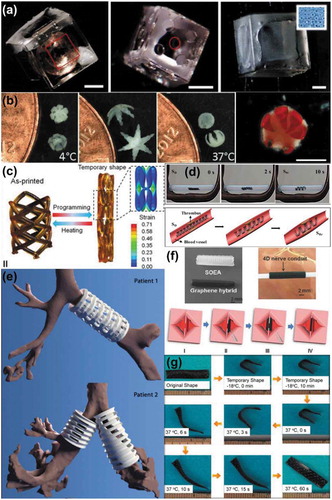
4D-printed medical devices. (a) Photolithographically fabricated polymeric containers, intended for drug delivery, with different patterned porous faces outlined in red. (b) Thermo-responsive shape change demonstration of a theragripper. (c) 4D-printed stent (d) A 4D-printed magnetic stent (e) 4D-printed air-way splints that have been surgically implanted (f) A 4D-printed nerve guidance conduit (g) Shape memory demonstration of 4D-printed scaffold.

(a) Soft McKibben type actuator made from porous silicon elastomer with the pores filled with ethanol (b) Demonstration of 4D printed thermo-responsive liquid crystal elastomer used for adaptive optics (c) 4D-printed polylactic acid braided tube preform demonstrating thermo-responsive shape memory behavior as a gripper (d) 4D-printed SMP gripper (e) 3D-printed hydraulic robot using liquid support for bellow actuators.
[Source / Image: ‘Developments in 4D-printing: a review on current smart materials, technologies, and applications’]



